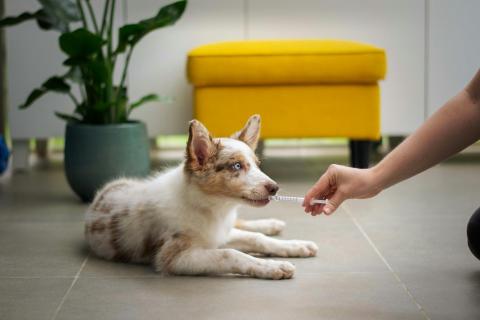Article examines how dogs can be 'sentinels' of human health
Dogs and other pets can be sentinels for human health, two US researchers argue in the journal Science. Because they share the same environment as their owners, dogs can help study, for example, the epidemiology of vector-borne pathogens, the effects of exposure to heavy metals and endocrine disruptors, and even the effects of social adversity. Improving canine data collection would help assess the health of people who cohabit with dogs, the authors argue.

Ramiro Pastorinho - exposoma perros EN
M. Ramiro Pastorinho
Department of Medical and Health Sciences, School of Health and Human Development and Comprehensive Health Research Centre, University of Évora, Portugal
A casual observation of human societies provides us with the notion that pets can be a company, provide protection, develop work, convey social status, and distract us in our moments of relaxation. By reading this perspective, the (not so obvious) role companion animals can perform as sentinels of public health, social welfare, and the health of individuals is highlighted. This is in line with the well-established One Health paradigm. This paradigm states that human, animal, and environmental health are interconnected, and that any unbalance of one of its components is going to be reflected in the other two (as exemplified by the all too recent SARS-CoV-2 pandemic). Sexton and Ruple propose a coalition between this century old paradigm and a relatively new concept: the Exposome.
Before delving into this alliance, some, not necessarily thorough, comments regarding Toxicology (as this is the categorization awarded to this perspective by Science, and being my basic training) of pets as sentinels are awarded:
- When a dog goes for a walk on a lawn, the inhalation exposure of pesticides is marginal. For example, the most worldwide used herbicide – the highly toxic, potentially carcinogenic, Glyphosate – is not volatile (exposure occurs mostly by ingestion of contaminated food and water).
- The belief that, among companion animals, dogs are the best positioned to perform the task of sentinels of toxic exposure is debatable. For instance, cats, due to their grooming habits (resembling children’s hand-to-mouth behaviors), are much better sentinels of exposure for toddlers.
- One of the fundamental differences between pets and their owners in the “developed world” (the context of this perspective), is what they eat, where most pets are fed with pre-packaged rations. Multiple known (and unknown) toxic chemicals in packaging migrate into food, solely affecting pets’ health.
As a side note: these comments highlight something truly fundamental in modern science: that it must be multi-inter(-and-hopefully)-transdisciplinary, so that by coming together, different groups of specialists can give birth to truly state-of-the-art concepts and constructs).
Getting back to Pets and the Exposome.
There is a truncated use of the Exposome concept in this perspective. The authors define it as “the combined elements of the physical and social environment, on an organism’s fitness”. A clearer definition could be “the measure of all the exposures of an individual in a lifetime and how those exposures relate to health” (CDC, 2019). In other words, the Exposome is the understanding of how exposures (since the preconception period) from environment, diet, lifestyle, etc. interact with unique individual attributes (e.g., genetics, physiology, and epigenetics) to impact health at an individual level. In practice, this demands accurate measurements of individual chemical exposures (by analyzing environmental and biological samples) and the related effects (mainly using “omics” - the study of an entire group of molecules pertaining to an organism or system, e.g., proteomics, genomics of the individual in question).
Besides being absent from this call to action (which is solely based on the proposal for collection of demographic data) the fact in itself – the collection of samples and analysis from each and every individual in order to characterize personal exposure – relinquishes the need for surrogates -or sentinels – no matter how representative -or cuddly- they might be.
Let us finish by saying that the proposal is valid. Since the concept of Exposome is, at this point, fully unattainable, we are obliged to, in the pursuit of understanding what makes us sick, obtain as much reliable information as we can. If it comes from a beautiful, faithful, and unyielding companion, better still.
Courtney Sexton & Audrey Ruple.
- Comment



